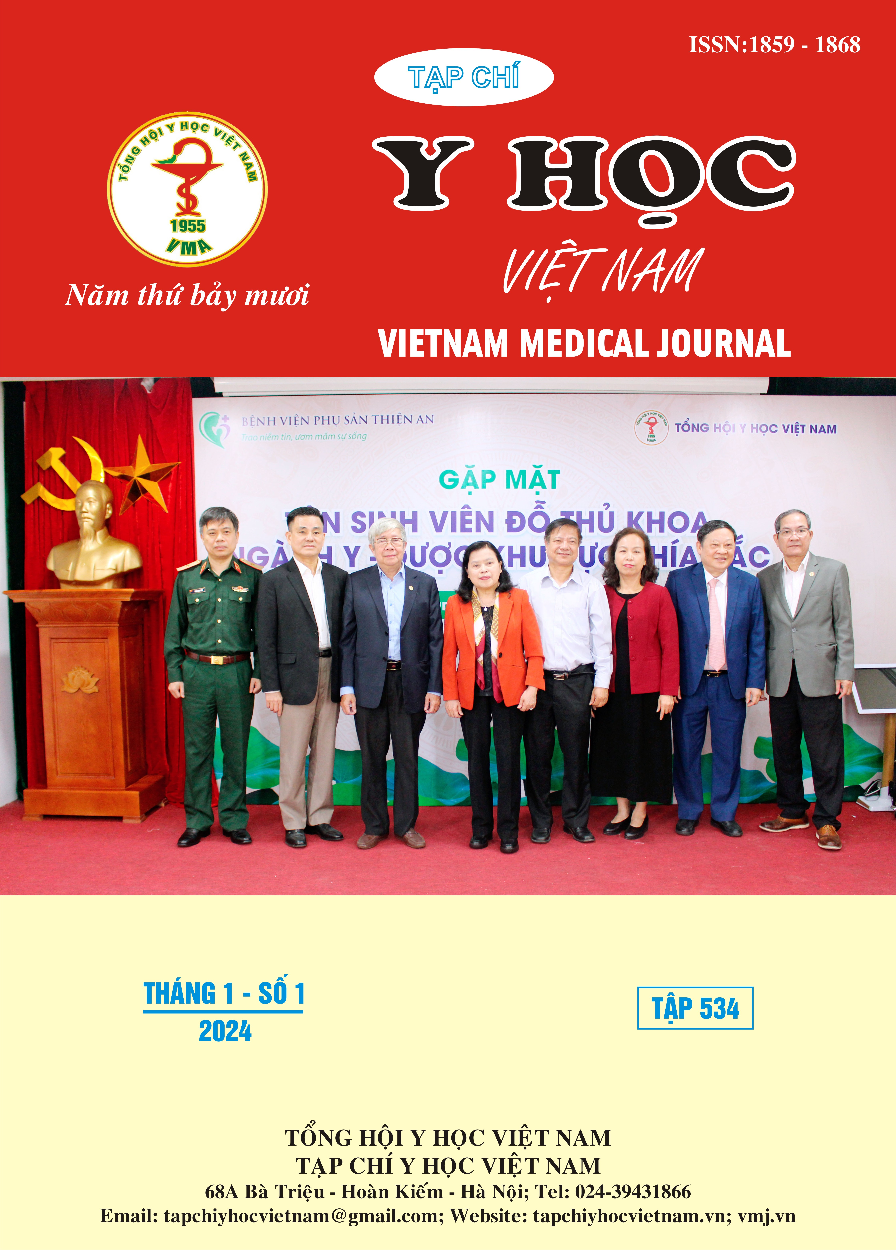ULTRASOUND AND POWER DOPPLER EVALUATION OF THE DISTAL INTERPHALANGEAL JOINTS IN PATIENTS WITH PSORIATIC ARTHRITIS
Main Article Content
Abstract
Objective: 1. To evaluate the frequency of the various lesions in distal interphalangeal joints of patients with psoriatic arthritis by clinical and ultrasound assessment. 2. To determine the correlation between grayscale and Power Doppler ultrasonography score with disease activity score. Methods: This cross-sectional study was performed on 41 patients, who were diagnosed with psoriatic arthritis by CASPAR 2006 criteria. The study duration lasts from October 2022 to August 2023 at the Rheumatology Center, Bach Mai Hospital. Results: Ultrasound detected more joint lesions than clinical examination. The proportion of patients with clinical distal interphalangeal arthritis was 12,2%. 100% of patients had at least one distal interphalangeal arthritis by ultrasound, and 27,6% of patients had periarticular soft tissue lesions. The frequency of various ultrasound abnormalities was as follows: Synovial hypertrophy was seen in 55,9%, Power Doppler abnormality suggesting hypervascularity in 52,5%. The periarticular lesion frequency: extensor tendonitis in 6,1%; loss of normal fibrillary architecture of extensor tendon erosions was seen in 14,4%; flexor tenositis in 7,1%; and other lesions were seen in 32,8% of patients. Significant correlation was found between DAPSA score and grayscale joint count (GSJC) (Spearman’s R=0,55; p<0,001), grayscale joint score (GSJS) (R=0,62; P<0,001), Power Doppler joint count (PDJC) (R=0.68; p<0,001), and Power Doppler joint score (PDJS) (R=78; p<0,001). Conclusion: Ultrasound can detect more joint lesions than clinical assessment. The severity of lesions on ultrasound correlates with the disease activity score.
Article Details
References
2. Psoriatic arthritis | Nature Reviews Disease Primers. Accessed September 19, 2023. https://www.nature.com/articles/s41572-021-00293-y
3. Acosta-Felquer ML, Ruta S, Rosa J, et al. Ultrasound entheseal abnormalities at the distal interphalangeal joints and clinical nail involvement in patients with psoriasis and psoriatic arthritis, supporting the nail-enthesitis theory. Semin Arthritis Rheum. 2017;47(3): 338-342. doi:10. 1016/ j.semarthrit. 2017.05.002
4. Arbault A, Devilliers H, Laroche D, et al. Reliability, validity and feasibility of nail ultrasonography in psoriatic arthritis. Joint Bone Spine. 2016; 83(5): 539-544. doi: 10.1016/ j.jbspin.2015.11.004
5. Schoels M, Aletaha D, Funovits J, Kavanaugh A, Baker D, Smolen JS. Application of the DAREA/DAPSA score for assessment of disease activity in psoriatic arthritis. Ann Rheum Dis. 2010;69(8):1441-1447. doi:10.1136/ard.2009.122259
6. Simpson MJ, Chow C, Morgenstern H, Luger TA, Ellis CN. Comparison of three methods for measuring psoriasis severity in clinical studies (Part 2 of 2): use of quality of life to assess construct validity of the Lattice System Physician’s Global Assessment, Psoriasis Area and Severity Index and Static Physician’s Global Assessment. J Eur Acad Dermatol Venereol JEADV. 2015;29(7):1415-1420. doi:10.1111/jdv.12861
7. Naredo E, Möller I, de Miguel E, et al. High prevalence of ultrasonographic synovitis and enthesopathy in patients with psoriasis without psoriatic arthritis: a prospective case-control study. Rheumatol Oxf Engl. 2011;50(10):1838-1848. doi:10.1093/rheumatology/ker078
8. Naranje P, Prakash M, Sharma A, Dogra S, Khandelwal N. Ultrasound Findings in Hand Joints Involvement in Patients with Psoriatic Arthritis and Its Correlation with Clinical DAS28 Score. Radiol Res Pract. 2015;2015:353657. doi:10.1155/2015/353657


